Seasonal Trends in Clouds and Radiation over the Arctic Seas from Satellite Observations during 1982 to 2019
Abstract
1. Introduction
2. Materials and Methods
2.1. Data
2.2. Methods
3. Results
3.1. Temporal Trends
3.2. Spatial Trends
3.3. Correlations with Sea Ice
4. Discussion
- (1)
- It could be noted that the analysis of the surface shortwave radiation is not included in this study. One of the main reasons is that our study focuses not only on the long-term seasonal variations and trends of Arctic clouds and radiation but also on the inter-comparisons between seasons. Considering that a large number of shortwave radiation data are invalid during the polar night in Arctic winter, it is difficult to form a complete analysis of seasonal variations and inter-comparisons between seasons. Additionally, the sea-ice loss or the rapid warming of the Arctic region occurs primarily during the non-melting season in Arctic when the sun’s altitude is extremely low. During this period, the atmospheric downward longwave radiation dominated by the greenhouse effect of atmospheric water vapor and clouds plays a key role in the Arctic surface radiation budget. Therefore, we chose clouds and longwave radiation as the study objects. It is well known that in the surface radiation budget, clouds participate in two main ways: warming the surface through the emission of longwave radiation and cooling the surface by shading the incident shortwave radiation. Adding shortwave radiation analysis would be helpful in interpreting the interactions between clouds, radiation, and sea ice. However, according to some studies [38,62,63], the accuracy of the shortwave radiation products from remote sensing is relatively low in the Arctic. Moreover, seasonal shortwave differences are obtained between satellite estimations and ground-based observations [63]. Improving the accuracy of Arctic shortwave radiation retrieval algorithm and establishing high-quality long-term datasets would be beneficial to the Arctic climate research.
- (2)
- Arctic sea-ice variability is an important indicator of the climate change. The mechanisms and interactions that lead to the Arctic sea-ice loss, which include lots of physical parameters and processes (e.g., clouds, radiation, sea ice, atmospheric circulation, ocean currents, sea-ice motion, and so on), are complicated and the related field is still an open question and difficult to be fully evaluated and analyzed based on literatures. For example, through analysis of CALIPSO Data, Taylor et al. [64] pointed out that the roles of clouds and sea ice in the Arctic climate system might be more complex than the previous assumptions. The increase of autumn cloud cover might delay or slow down the sea ice to refreeze. Thus, it could lead to thinner sea ice or make the sea ice be more likely to be influenced. When it turns to spring and summer, the sea ice might melt even faster. The decrease of sea ice could further lead to more frequent occurrence of low clouds with higher liquid water content. A recent study by Philipp et al. [65] presented that statistically significant anti-correlations between sea ice concentration and low-level cloud fraction are observed in October and November over melting zones using satellite observations of 34 years. They found that the interaction between sea ice concentration and low-level cloud fraction works through two-way feedback. Another study by Vavrus et al. [66] proposed that the loss of sea ice enhanced evaporation within the Arctic, which would influence the initiation of the low-level clouds locally. However, for the increase of the mid- or high- level clouds, the greater meridional moisture transport from lower latitudes could be a major driven factor. Based on the conclusions from the above literatures, the variations of the cloud fraction are not only related to the change of the atmospheric environment caused by the change of sea ice locally but also to the moisture transport caused by the atmospheric circulation remotely. Moreover, the interactions are closely related to the height level information of the clouds. It is difficult to give a reliable conclusion on which physical parameter or physical process plays a leading role in the variations of the Arctic cloud fraction only by relying on observation data analysis in this study. Further work should be done combined with models and multiple kinds of observations, in order to obtain more reliable and accurate analysis on the cloud-sea ice-radiation interactions.
- (3)
- The correlation analysis between autumnal sea ice and seasonal clouds/radiation in this study is based on the Pearson’s correlation coefficient. Additionally, the analysis is within the seasons of the same year, e.g., the correlations between clouds in spring or other seasons and sea ice in autumn of the same year. The correlation result here could only indicate that there is a significant negative correlation between cloud fraction and sea ice concentration during autumn but without supporting information about specific causal links between theses parameters. Some studies have revealed that the interactions between clouds/radiation and sea ice are more likely to occur on a smaller time scale. For example, Cox et al. [67] found that the net cloud radiative forcing from April to May measured at Barrow (1993–2014) is significantly negatively correlated with the sea ice extent of the following September. Huang et al. [27] found that the time period, which the cloud/radiation has significant impact on the September sea ice loss, is primarily during 31 March to 29 April. It would be better to carry out a lag-correlation analysis to investigate the causal relationships not on a seasonal scale but on a monthly or even daily scale. Moreover, Philipp et al. [65] in a recent study firstly employed Granger causality (GC) method (accepted in economics) for the analysis of Arctic sea ice and clouds. They found that a causal two-way interaction between sea ice concentration and low-level cloud fraction, with the impact of sea ice concentration on low-level cloud fraction to be likely stronger than the reverse. More advanced methods of analysis should be adopted in future works, which will provide quantitative assessment of the impact parameters.
- (4)
- The stability is an important indicator for the availability of the long-term dataset. Due to the influence of various factors such as satellite replacement, payload performance, orbit drift and so on, the stability and uncertainties of the long-term series satellite dataset are faced with challenges. The APP-x climate data record of version 2.0 used for the analysis here is a thematic climate data record derived from NOAA/AVHRR. According to the algorithm theoretical basis document of APP-x version 2.0 [41], it reprocessed the entire data record (since 1982) with the latest calibration coefficients of May 2018 for improving the consistency and stability of the dataset. The inter-satellite differences have also been considered in the calibration method. In particular, the cloud fraction and the surface radiative longwave fluxes used here are considered to be of CDR quality. Although the APP-x dataset has been applied for Arctic long-term climate analysis, e.g., [24,25,31,39], it might bring some unavoidable biases. Affected by the complex Arctic environment, such as snow/ice surface and temperature inverse, the accuracy of the retrieval products by passive optical remote sensing still needs to be improved. Although the long-term dataset used here has been revised to minimize the biases, there might be some deviations, which could affect our results.
5. Conclusions
- (1)
- On the temporal scale, the inter-annual average CF in spring, summer, and autumn maintains a relatively stable level. The changes of inter-annual CF in winter present a fluctuating pattern. A positive trend in CF has been found in each season over the period of 2008 to 2019, while no obvious trend has been found from 1982 to 2007. Significant positive trends in DLF and ULF have been found since 1982. The ULF shows more distinct positive trend than the DLF. The increase of DLF and ULF is relatively more obvious in autumn and winter.
- (2)
- On the spatial scale, the trends in CF are different between seasons. Over the Kara and Barents Seas, the CF maintains a positive trend in each season. Over the Chukchi and Beaufort Seas, the CF presents a negative trend in spring and a pronounced positive trend in autumn. For DLF and ULF, the areas with significant positive trends get to the maximum in autumn. Over the Kara and Barents Seas, the positive trend in DLF or ULF is pronounced in each season except summer. Over the East Siberian, Chukchi, and Beaufort Seas, the positive trend in DLF or ULF is relatively more significant in autumn.
- (3)
- The correlations between the autumn SIC and CF, DLF, ULF in each season of the same year were evaluated. Both DLF and ULF are negatively correlated with autumn SIC in each season, and the negative relationship is more pronounced during autumn. The correlation between CF and autumn SIC is not as strong as that between DLF (ULF) and SIC. During autumn, significant negative correlations between CF and SIC have been found over the regions with prominent retreat of sea ice. In spring, a positive correlation between CF and autumn SIC occurs over the Chukchi, Beaufort Seas, and Canadian archipelago.
Supplementary Materials
Author Contributions
Funding
Institutional Review Board Statement
Informed Consent Statement
Data Availability Statement
Acknowledgments
Conflicts of Interest
References
- Wang, Y.; Bi, H.; Huang, H.; Liu, Y.; Liu, Y.; Liang, X.; Fu, M.; Zhang, Z. Satellite-observed trends in the Arctic sea ice concentration for the period 1979–2016. J. Oceanol. Limnol. 2019, 37, 18–37. [Google Scholar] [CrossRef]
- Zhan, Y.; Davies, R. September Arctic sea ice extent indicated by June reflected solar radiation. J. Geophys. Res. Atmos. 2017, 122, 2194–2202. [Google Scholar] [CrossRef]
- Parkinson, C.L.; DiGirolamo, N.E. New visualizations highlight new information on the contrasting Arctic and Antarctic sea-ice trends since the late 1970s. Remote Sens. Environ. 2016, 183, 198–204. [Google Scholar] [CrossRef]
- Petty, A.A.; Stroeve, J.C.; Holland, P.R.; Boisvert, L.N.; Bliss, A.C.; Kimura, N.; Meier, W.N. The Arctic sea ice cover of 2016: A year of record-low highs and higher-than-expected lows. Cryosphere 2018, 12, 433–452. [Google Scholar] [CrossRef]
- Bliss, A.C.; Steele, M.; Peng, G.; Meier, W.N.; Dickinson, S. Regional variability of Arctic sea ice seasonal change climate indicators from a passive microwave climate data record. Environ. Res. Lett. 2019, 14, 045003. [Google Scholar] [CrossRef]
- Kumar, A.; Yadav, J.; Mohan, R. Global warming leading to alarming recession of the Arctic sea-ice cover: Insights from remote sensing observations and model reanalysis. Heliyon 2020, 6, e04355. [Google Scholar] [CrossRef]
- Desmarais, A.l.; Tremblay, L.B. Assessment of Decadal Variability in Sea Ice in the Community Earth System Model against a Long-Term Regional Observational Record: Implications for the Predictability of an Ice-Free Arctic. J. Clim. 2021, 34, 5367–5384. [Google Scholar] [CrossRef]
- Kay, J.E.; L’Ecuyer, T.; Gettelman, A.; Stephens, G.; O’Dell, C. The contribution of cloud and radiation anomalies to the 2007 Arctic sea ice extent minimum. Geophys. Res. Lett. 2008, 35. [Google Scholar] [CrossRef]
- Eastman, R.; Warren, S.G. Arctic Cloud Changes from Surface and Satellite Observations. J. Clim. 2010, 23, 4233–4242. [Google Scholar] [CrossRef]
- Kapsch, M.-L.; Graversen, R.G.; Tjernström, M.; Bintanja, R. The Effect of Downwelling Longwave and Shortwave Radiation on Arctic Summer Sea Ice. J. Clim. 2016, 29, 1143–1159. [Google Scholar] [CrossRef]
- Boccolari, M.; Parmiggiani, F. Trends and variability of cloud fraction cover in the Arctic, 1982–2009. Theor. Appl. Climatol. 2018, 132, 739–749. [Google Scholar] [CrossRef]
- Curry, J.A.; Ebert, E.E. Annual Cycle of Radiation Fluxes over the Arctic Ocean: Sensitivity to Cloud Optical Properties. J. Clim. 1992, 5, 1267–1280. [Google Scholar] [CrossRef]
- Curry, J.A.; Schramm, J.L.; Ebert, E.E. Impact of clouds on the surface radiation balance of the Arctic Ocean. Meteorol. Atmos. Phys. 1993, 51, 197–217. [Google Scholar] [CrossRef]
- Curry, J.A.; Schramm, J.L.; Rossow, W.B.; Randall, D. Overview of Arctic Cloud and Radiation Characteristics. J. Clim. 1996, 9, 1731–1764. [Google Scholar] [CrossRef]
- Liu, Y.; Key, J.R.; Liu, Z.; Wang, X.; Vavrus, S.J. A cloudier Arctic expected with diminishing sea ice. Geophys. Res. Lett. 2012, 39. [Google Scholar] [CrossRef]
- Palm, S.P.; Strey, S.T.; Spinhirne, J.; Markus, T. Influence of Arctic sea ice extent on polar cloud fraction and vertical structure and implications for regional climate. J. Geophys. Res. Atmos. 2010, 115. [Google Scholar] [CrossRef]
- Shupe, M.D.; Intrieri, J.M. Cloud Radiative Forcing of the Arctic Surface: The Influence of Cloud Properties, Surface Albedo, and Solar Zenith Angle. J. Clim. 2004, 17, 616–628. [Google Scholar] [CrossRef]
- Intrieri, J.M.; Fairall, C.W.; Shupe, M.D.; Persson, P.O.G.; Andreas, E.L.; Guest, P.S.; Moritz, R.E. An annual cycle of Arctic surface cloud forcing at SHEBA. J. Geophys. Res. Ocean. 2002, 107, SHE 13-1–SHE 13-14. [Google Scholar] [CrossRef]
- Huang, Y.; Dong, X.; Xi, B.; Dolinar, E.K.; Stanfield, R.E.; Qiu, S. Quantifying the Uncertainties of Reanalyzed Arctic Cloud and Radiation Properties Using Satellite Surface Observations. J. Clim. 2017, 30, 8007–8029. [Google Scholar] [CrossRef]
- Chernokulsky, A.; Mokhov, I. Climatology of Total Cloudiness in the Arctic: An Intercomparison of Observations and Reanalyses. Adv. Meteorol. 2012, 2012, 542093. [Google Scholar] [CrossRef]
- Zygmuntowska, M.; Mauritsen, T.; Quaas, J.; Kaleschke, L. Arctic Clouds and Surface Radiation—A critical comparison of satellite retrievals and the ERA-Interim reanalysis. Atmos. Chem. Phys. 2012, 12, 6667–6677. [Google Scholar] [CrossRef]
- Schweiger, A.J.; Key, J.R. Arctic Cloudiness. Comparison of ISCCP-C2 and Nimbus-7 Satellite-derived Cloud Products with a Surface-based Cloud Climatology. J. Clim. 1992, 5, 1514–1527. [Google Scholar] [CrossRef]
- Eastman, R.; Warren, S.G. Interannual Variations of Arctic Cloud Types in Relation to Sea Ice. J. Clim. 2010, 23, 4216–4232. [Google Scholar] [CrossRef]
- Schweiger, A.J. Changes in seasonal cloud cover over the Arctic seas from satellite and surface observations. Geophys. Res. Lett. 2004, 31. [Google Scholar] [CrossRef]
- Wang, X.; Key, J.R. Arctic Surface, Cloud, and Radiation Properties Based on the AVHRR Polar Pathfinder Dataset. Part II: Recent Trends. J. Clim. 2005, 18, 2575–2593. [Google Scholar] [CrossRef]
- Comiso, J.C. Warming Trends in the Arctic from Clear Sky Satellite Observations. J. Clim. 2003, 16, 3498–3510. [Google Scholar] [CrossRef]
- Huang, Y.; Dong, X.; Xi, B.; Dolinar, E.K.; Stanfield, R.E. The footprints of 16 year trends of Arctic springtime cloud and radiation properties on September sea ice retreat. J. Geophys. Res. Atmos. 2017, 122, 2179–2193. [Google Scholar] [CrossRef]
- Wielicki, B.A.; Barkstrom, B.R.; Harrison, E.F.; Lee, R.B.; Smith, G.L.; Cooper, J.E. Clouds and the Earth’s Radiant Energy System (CERES): An Earth Observing System Experiment. Bull. Am. Meteorol. Soc. 1996, 77, 853–868. [Google Scholar] [CrossRef]
- Schweiger, A.J.; Key, J.R. Arctic Ocean Radiative Fluxes and Cloud Forcing Estimated from the ISCCP C2 Cloud Dataset, 1983–1990. J. Appl. Meteorol. 1994, 33, 948–963. [Google Scholar] [CrossRef][Green Version]
- Walsh, J.E.; Chapman, W.L. Arctic Cloud–Radiation–Temperature Associations in Observational Data and Atmospheric Reanalyses. J. Clim. 1998, 11, 3030–3045. [Google Scholar] [CrossRef]
- Wang, X.; Key, J.R. Recent Trends in Arctic Surface, Cloud, and Radiation Properties from Space. Science 2003, 299, 1725. [Google Scholar] [CrossRef]
- Vavrus, S. The Impact of Cloud Feedbacks on Arctic Climate under Greenhouse Forcing. J. Clim. 2004, 17, 603–615. [Google Scholar] [CrossRef]
- Dong, X.; Xi, B.; Crosby, K.; Long, C.N.; Stone, R.S.; Shupe, M.D. A 10 year climatology of Arctic cloud fraction and radiative forcing at Barrow, Alaska. J. Geophys. Res. Atmos. 2010, 115. [Google Scholar] [CrossRef]
- Kapsch, M.-L.; Graversen, R.G.; Tjernström, M. Springtime atmospheric energy transport and the control of Arctic summer sea-ice extent. Nat. Clim. Chang. 2013, 3, 744–748. [Google Scholar] [CrossRef]
- Schweiger, A.J.; Lindsay, R.W.; Vavrus, S.; Francis, J.A. Relationships between Arctic Sea Ice and Clouds during Autumn. J. Clim. 2008, 21, 4799–4810. [Google Scholar] [CrossRef]
- Wu, D.L.; Lee, J.N. Arctic low cloud changes as observed by MISR and CALIOP: Implication for the enhanced autumnal warming and sea ice loss. J. Geophys. Res. Atmos. 2012, 117. [Google Scholar] [CrossRef]
- Jun, S.-Y.; Ho, C.-H.; Jeong, J.-H.; Choi, Y.-S.; Kim, B.-M. Recent changes in winter Arctic clouds and their relationships with sea ice and atmospheric conditions. Tellus A Dyn. Meteorol. Oceanogr. 2016, 68, 29130. [Google Scholar] [CrossRef]
- Key, J. The AVHRR Polar Pathfinder Climate Data Records. Remote Sens. 2016, 8, 167. [Google Scholar] [CrossRef]
- Wang, X.; Key, J.R. Arctic Surface, Cloud, and Radiation Properties Based on the AVHRR Polar Pathfinder Dataset. Part I: Spatial and Temporal Characteristics. J. Clim. 2005, 18, 2558–2574. [Google Scholar] [CrossRef]
- Key, J.; Lui, Y.; Wang, X. NOAA CDR Program (2019): NOAA Climate Data Record (CDR) of AVHRR Polar Pathfinder (APP) Cryosphere, Version 2.0. 2019. Available online: https://www.ncei.noaa.gov/access/metadata/landing-page/bin/iso?id=gov.noaa.ncdc:C01579 (accessed on 15 January 2020).
- Key, J.; Wang, X. Climate Algorithm Theoretical Basis Document (C-ATBD) Extended AVHRR Polar Pathfinder (APP-x). Available online: https://www.ncei.noaa.gov/pub/data/sds/cdr/CDRs/AVHRR_Extended_Polar_Pathfinder/AlgorithmDescription_01B-24b.pdf (accessed on 15 January 2020).
- Key, J.; Wang, X. Climate Algorithm Theoretical Basis Document (C-ATBD) AVHRR Polar Pathfinder (APP). Available online: https://www.ncei.noaa.gov/pub/data/sds/cdr/CDRs/AVHRR_Polar_Pathfinder/AlgorithmDescription_01B-24a.pdf (accessed on 15 January 2020).
- Peng, G.; Meier, W.; Scott, D.; Savoie, M. A long-term and reproducible passive microwave sea ice concentration data record for climate studies and monitoring. Earth Syst. Sci. Data 2013, 5, 311–318. [Google Scholar] [CrossRef]
- Meier, W.N.; Fetterer, F.; Savoie, M.; Mallory, S.; Duerr, R.; Stroeve, J. NOAA/NSIDC Climate Data Record of Passive Microwave Sea Ice Concentration, Version 3. 2017. Available online: https://nsidc.org/data/g02202/versions/3 (accessed on 23 July 2020).
- Meier, W.; Windnagel, A. Climate Algorithm Theoretical Basis Document (C-ATBD) Sea Ice Concentration. Available online: https://nsidc.org/sites/nsidc.org/files/technical-references/SeaIce_CDR_CATBD_final_Rev-7.pdf (accessed on 27 July 2020).
- Windnagel, A. NOAA/NSIDC Climate Data Record of Passive Microwave Sea Ice Concentration, Version 3 USER GUIDE. Available online: https://nsidc.org/sites/nsidc.org/files/G02202-V001-UserGuide.pdf (accessed on 20 July 2021).
- Cavalieri, D.J.; Gloersen, P.; Campbell, W.J. Determination of sea ice parameters with the NIMBUS 7 SMMR. J. Geophys. Res. Atmos. 1984, 89, 5355–5369. [Google Scholar] [CrossRef]
- Comiso, J.C. Characteristics of Arctic winter sea ice from satellite multispectral microwave observations. J. Geophys. Res. Ocean. 1986, 91, 975–994. [Google Scholar] [CrossRef]
- Kern, S.; Lavergne, T.; Notz, D.; Pedersen, L.T.; Tonboe, R.T.; Saldo, R.; Sørensen, A.M. Satellite passive microwave sea-ice concentration data set intercomparison: Closed ice and ship-based observations. Cryosphere 2019, 13, 3261–3307. [Google Scholar] [CrossRef]
- Kern, S.; Lavergne, T.; Notz, D.; Pedersen, L.T.; Tonboe, R. Satellite passive microwave sea-ice concentration data set inter-comparison for Arctic summer conditions. Cryosphere 2020, 14, 2469–2493. [Google Scholar] [CrossRef]
- Stuart, A. Rank Correlation Methods. By M. G. Kendall, 2nd edition. Br. J. Stat. Psychol. 1956, 9, 68. [Google Scholar] [CrossRef]
- Kamal, N.; Pachauri, S. Mann-Kendall Test—A Novel Approach for Statistical Trend Analysis. Int. J. Comput. Trends Technol. 2018, 63, 18–21. [Google Scholar] [CrossRef]
- Sen, P.K. Estimates of the Regression Coefficient Based on Kendall’s Tau. J. Am. Stat. Assoc. 1968, 63, 1379–1389. [Google Scholar] [CrossRef]
- Gilbert, R.O. Statistical Methods for Environmental Pollution Monitoring; John Wiley & Sons: New York, NY, USA, 1987; p. 336. [Google Scholar]
- Gocic, M.; Trajkovic, S. Analysis of changes in meteorological variables using Mann-Kendall and Sen’s slope estimator statistical tests in Serbia. Glob. Planet. Chang. 2013, 100, 172–182. [Google Scholar] [CrossRef]
- Liu, Y.; Key, J.R.; Wang, X. The Influence of Changes in Cloud Cover on Recent Surface Temperature Trends in the Arctic. J. Clim. 2008, 21, 705–715. [Google Scholar] [CrossRef]
- Tjernström, M.; Sedlar, J.; Shupe, M.D. How Well Do Regional Climate Models Reproduce Radiation and Clouds in the Arctic? An Evaluation of ARCMIP Simulations. J. Appl. Meteorol. Climatol. 2008, 47, 2405–2422. [Google Scholar] [CrossRef]
- Liu, Y.; Key, J.R.; Wang, X. Influence of changes in sea ice concentration and cloud cover on recent Arctic surface temperature trends. Geophys. Res. Lett. 2009, 36. [Google Scholar] [CrossRef]
- Kay, J.E.; Gettelman, A. Cloud influence on and response to seasonal Arctic sea ice loss. J. Geophys. Res. Atmos. 2009, 114. [Google Scholar] [CrossRef]
- Morrison, A.; Kay, J.; Chepfer, H.; Guzman, R.; Yettella, V. Isolating the Liquid Cloud Response to Recent Arctic Sea Ice Variability Using Spaceborne Lidar Observations. J. Geophys. Res. Atmos. 2018, 123, 473–490. [Google Scholar] [CrossRef]
- Sato, K.; Inoue, J.; Kodama, Y.-M.; Overland, J.E. Impact of Arctic sea-ice retreat on the recent change in cloud-base height during autumn. Geophys. Res. Lett. 2012, 39. [Google Scholar] [CrossRef]
- Riihelä, A.; Key, J.R.; Meirink, J.F.; Kuipers Munneke, P.; Palo, T.; Karlsson, K.-G. An intercomparison and validation of satellite-based surface radiative energy flux estimates over the Arctic. J. Geophys. Res. Atmos. 2017, 122, 4829–4848. [Google Scholar] [CrossRef]
- Sun, D.; Ji, C.; Sun, W.; Yang, Y.; Wang, H. Accuracy assessment of three remote sensing shortwave radiation products in the Arctic. Atmos. Res. 2018, 212, 296–308. [Google Scholar] [CrossRef]
- Taylor, P.C.; Kato, S.; Xu, K.-M.; Cai, M. Covariance between Arctic sea ice and clouds within atmospheric state regimes at the satellite footprint level. J. Geophys. Res. Atmos. 2015, 120, 12656–12678. [Google Scholar] [CrossRef]
- Philipp, D.; Stengel, M.; Ahrens, B. Analyzing the Arctic Feedback Mechanism between Sea Ice and Low-Level Clouds Using 34 Years of Satellite Observations. J. Clim. 2020, 33, 7479–7501. [Google Scholar] [CrossRef]
- Vavrus, S.J.; Bhatt, U.S.; Alexeev, V.A. Factors Influencing Simulated Changes in Future Arctic Cloudiness. J. Clim. 2011, 24, 4817–4830. [Google Scholar] [CrossRef]
- Cox, C.J.; Uttal, T.; Long, C.N.; Shupe, M.D.; Stone, R.S.; Starkweather, S. The Role of Springtime Arctic Clouds in Determining Autumn Sea Ice Extent. J. Clim. 2016, 29, 6581–6596. [Google Scholar] [CrossRef]
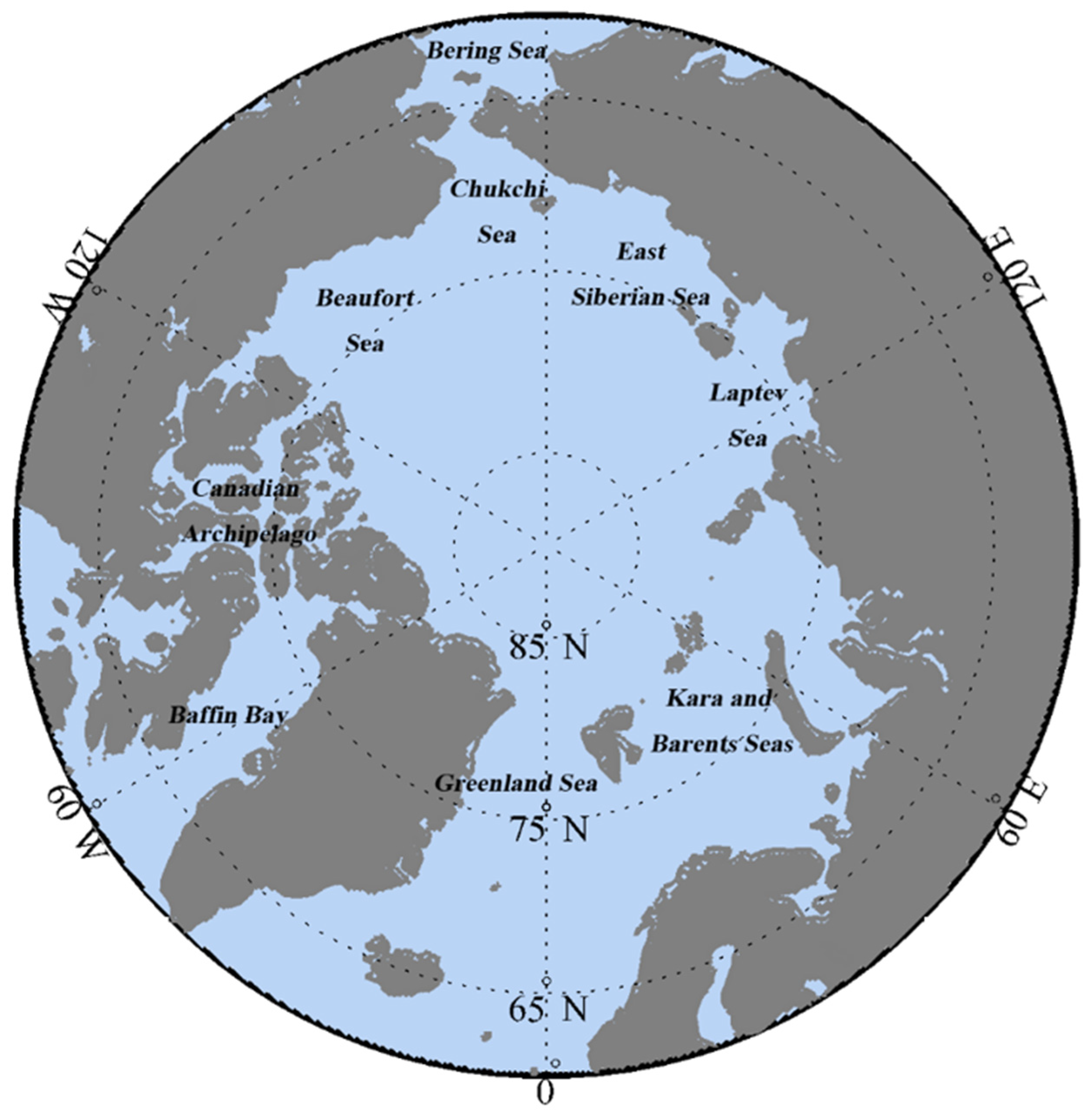
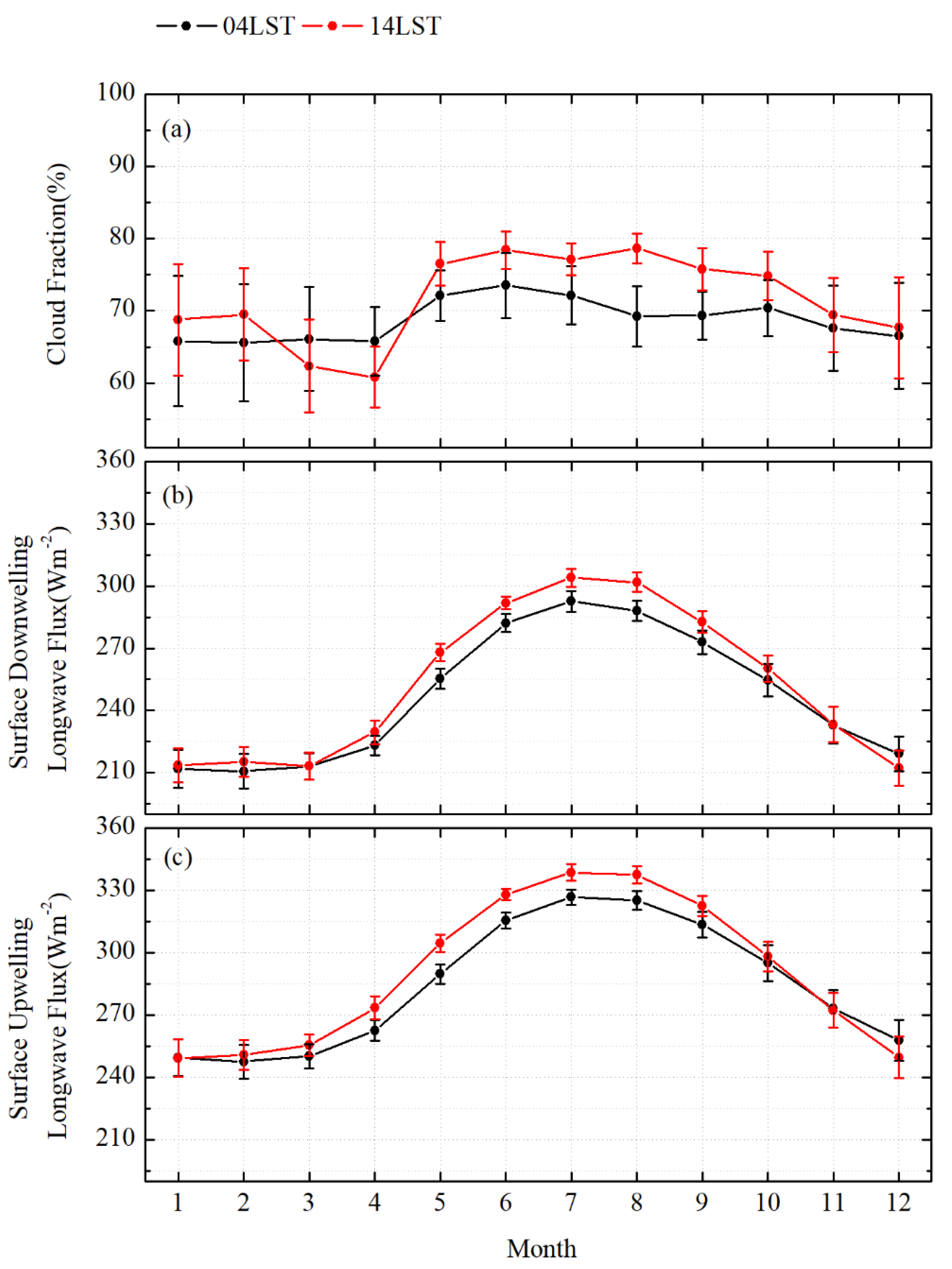
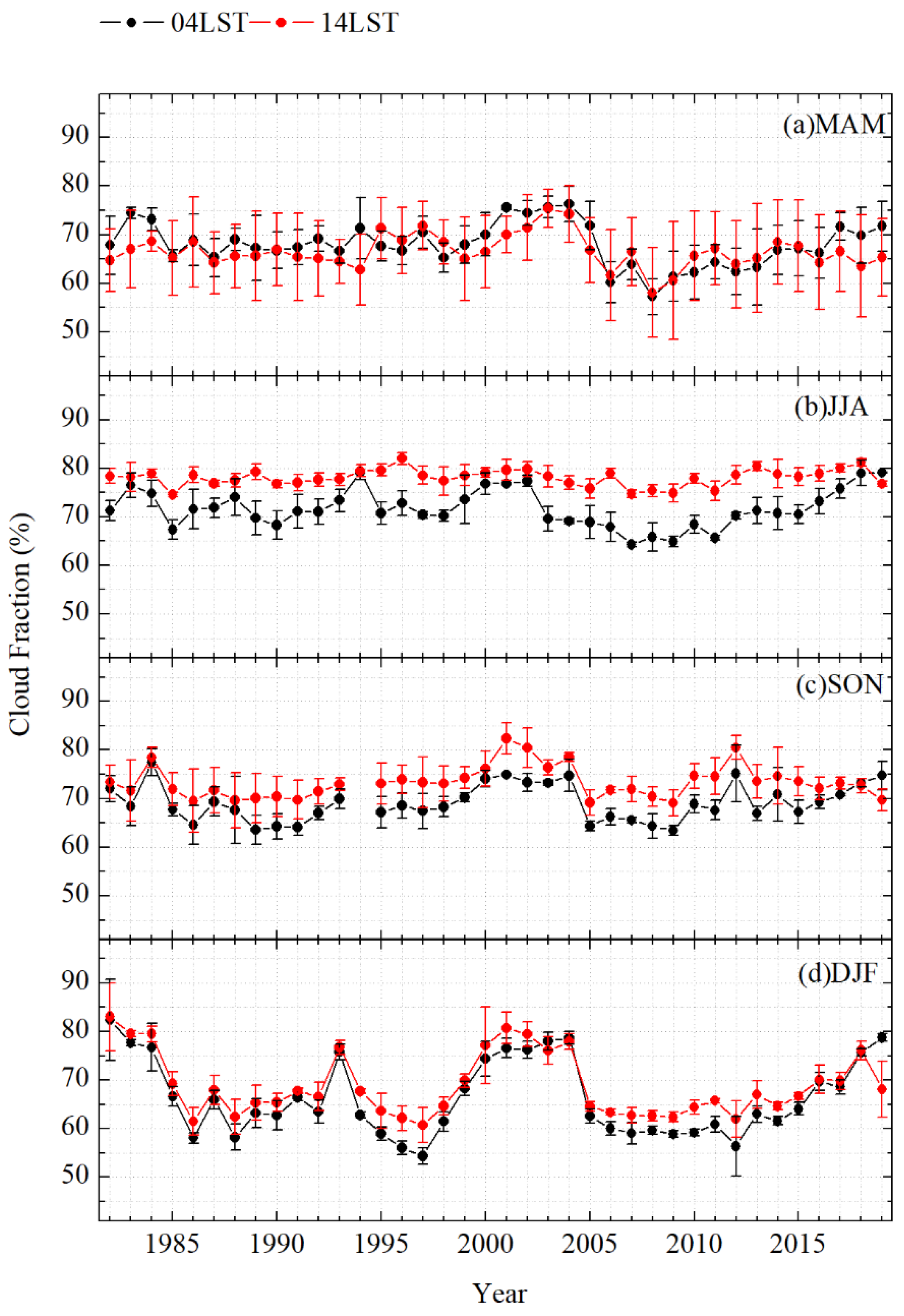

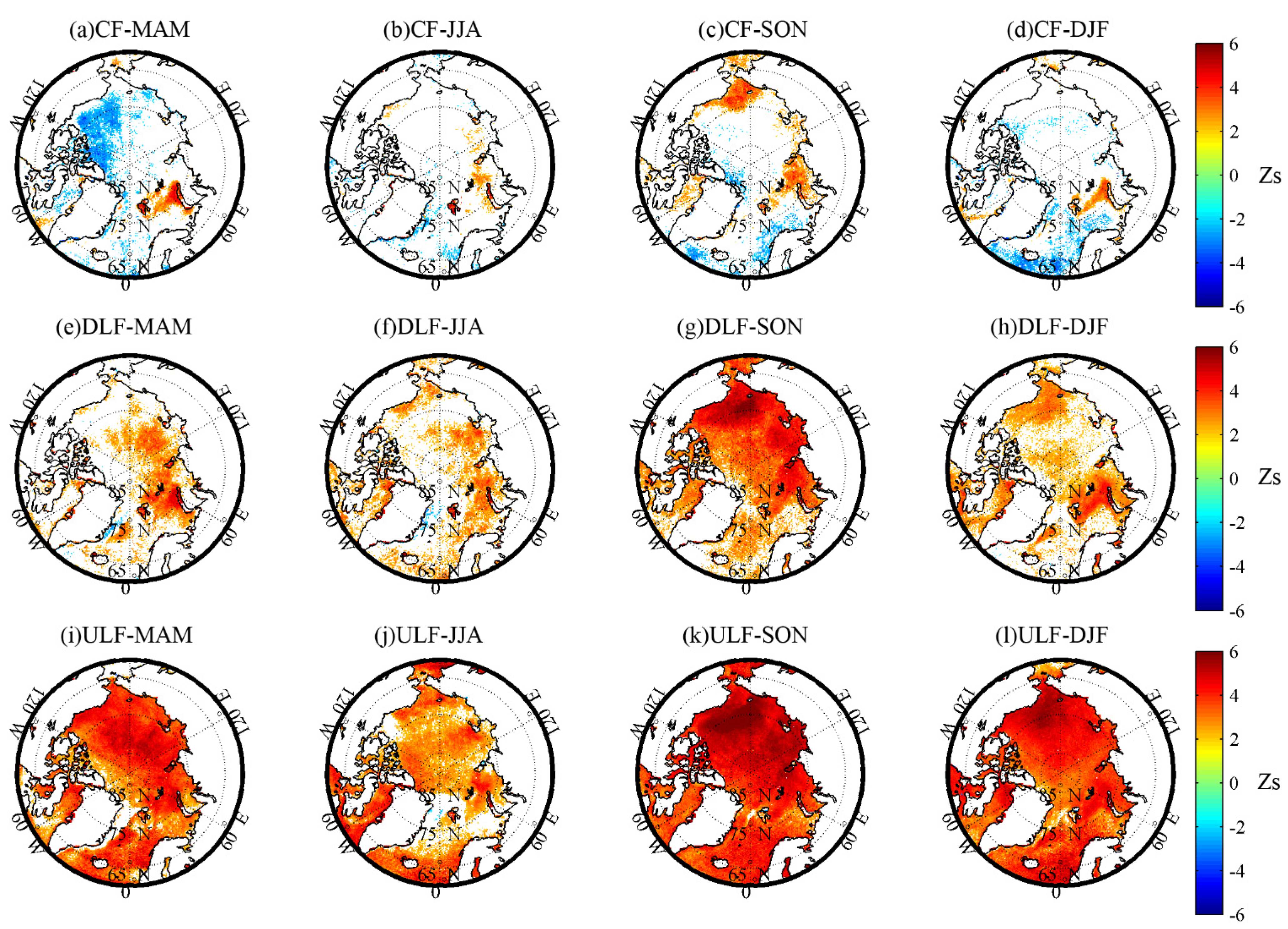
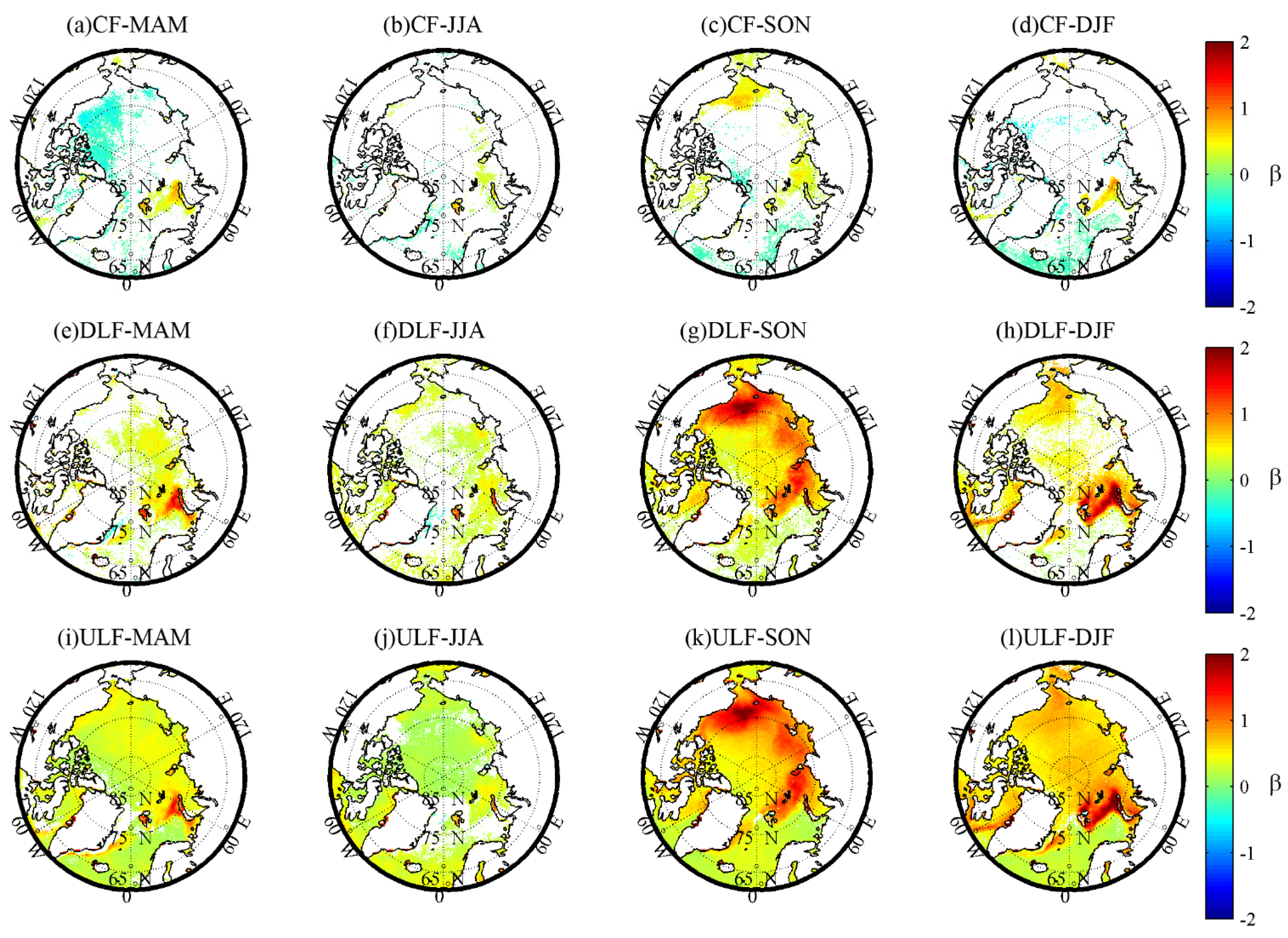

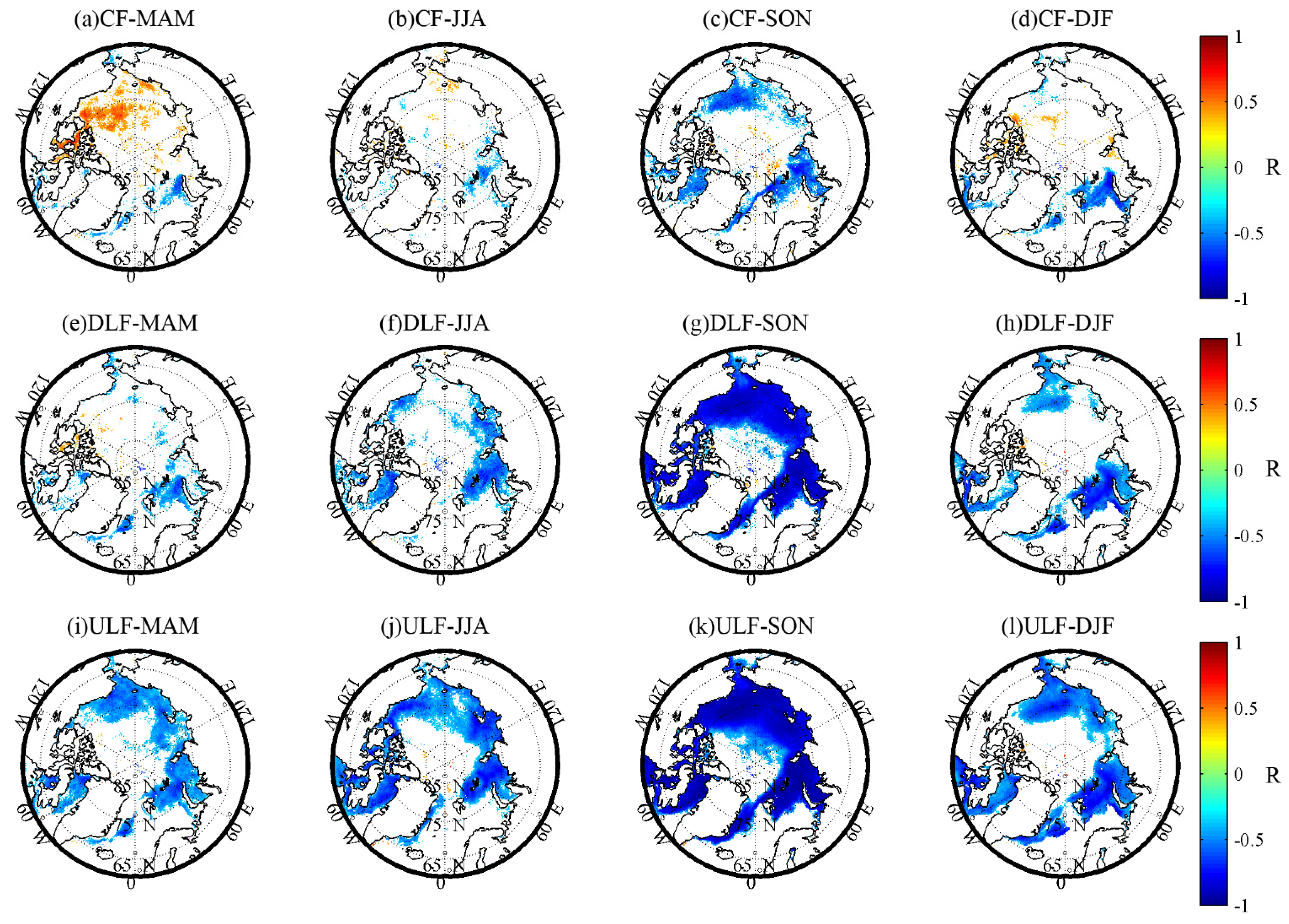
| Season | LST | Mean (%) | Standard Deviation (%) |
|---|---|---|---|
| MAM | 04 | 68.0 | 4.4 |
| 14 | 66.5 | 3.4 | |
| JJA | 04 | 71.6 | 3.9 |
| 14 | 78.1 | 1.7 | |
| SON | 04 | 69.1 | 3.8 |
| 14 | 73.3 | 3.3 | |
| DJF | 04 | 66.4 | 7.8 |
| 14 | 68.8 | 6.4 |
| Season | LST | 1982–2007 | 2008–2019 | ||
|---|---|---|---|---|---|
| Zs | β | Zs | β | ||
| MAM | 04 | 0.705 | 0.085 | 3.771 ** | 1.134 ** |
| 14 | 1.278 | 0.098 | 0.891 | 0.346 | |
| JJA | 04 | −1.410 | −0.133 | 3.634 ** | 1.219 ** |
| 14 | 0.440 | 0.022 | 2.125 * | 0.415 * | |
| SON | 04 | 0.490 | 0.077 | 2.262 * | 0.828 * |
| 14 | 1.985 * | 0.168 * | −0.891 | −0.213 | |
| DJF | 04 | −0.573 | −0.165 | 3.360 ** | 1.690 ** |
| 14 | −0.881 | −0.128 | 2.811 ** | 0.868 ** | |
| Season | LST | DLF | ULF | ||
|---|---|---|---|---|---|
| Zs | β | Zs | β | ||
| MAM | 04 | 3.444 ** | 0.210 ** | 5.808 ** | 0.347 ** |
| 14 | 3.620 ** | 0.241 ** | 5.179 ** | 0.334 ** | |
| JJA | 04 | 2.640 ** | 0.170 ** | 4.023 ** | 0.222 ** |
| 14 | 5.355 ** | 0.235 ** | 5.079 ** | 0.190 ** | |
| SON | 04 | 5.741 ** | 0.578 ** | 6.761 ** | 0.659 ** |
| 14 | 4.930 ** | 0.463 ** | 6.160 ** | 0.522 ** | |
| DJF | 04 | 3.494 ** | 0.450 ** | 5.079 ** | 0.627 ** |
| 14 | 3.268 ** | 0.390 ** | 4.777 ** | 0.585 ** | |
Publisher’s Note: MDPI stays neutral with regard to jurisdictional claims in published maps and institutional affiliations. |
© 2021 by the authors. Licensee MDPI, Basel, Switzerland. This article is an open access article distributed under the terms and conditions of the Creative Commons Attribution (CC BY) license (https://creativecommons.org/licenses/by/4.0/).
Share and Cite
Wang, X.; Liu, J.; Yang, B.; Bao, Y.; Petropoulos, G.P.; Liu, H.; Hu, B. Seasonal Trends in Clouds and Radiation over the Arctic Seas from Satellite Observations during 1982 to 2019. Remote Sens. 2021, 13, 3201. https://doi.org/10.3390/rs13163201
Wang X, Liu J, Yang B, Bao Y, Petropoulos GP, Liu H, Hu B. Seasonal Trends in Clouds and Radiation over the Arctic Seas from Satellite Observations during 1982 to 2019. Remote Sensing. 2021; 13(16):3201. https://doi.org/10.3390/rs13163201
Chicago/Turabian StyleWang, Xi, Jian Liu, Bingyun Yang, Yansong Bao, George P. Petropoulos, Hui Liu, and Bo Hu. 2021. "Seasonal Trends in Clouds and Radiation over the Arctic Seas from Satellite Observations during 1982 to 2019" Remote Sensing 13, no. 16: 3201. https://doi.org/10.3390/rs13163201
APA StyleWang, X., Liu, J., Yang, B., Bao, Y., Petropoulos, G. P., Liu, H., & Hu, B. (2021). Seasonal Trends in Clouds and Radiation over the Arctic Seas from Satellite Observations during 1982 to 2019. Remote Sensing, 13(16), 3201. https://doi.org/10.3390/rs13163201









